how to use a stethoscope
Being a symbol of any physician and pediatrician, today, a stethoscope does not seem anything special even for a home user. Almost everybody knows the basics and will intuitively put eartips into ears and a diaphragm on a sick person's chest to listen to lungs. However, only few people know the proper way to use a stethoscope. If you are new to medicine, in our article, you'll find detailed information on different kinds of stethoscopes, and auscultation techniques, and useful tips on how to use stethoscope efficiently.
Different Types of Stethoscope
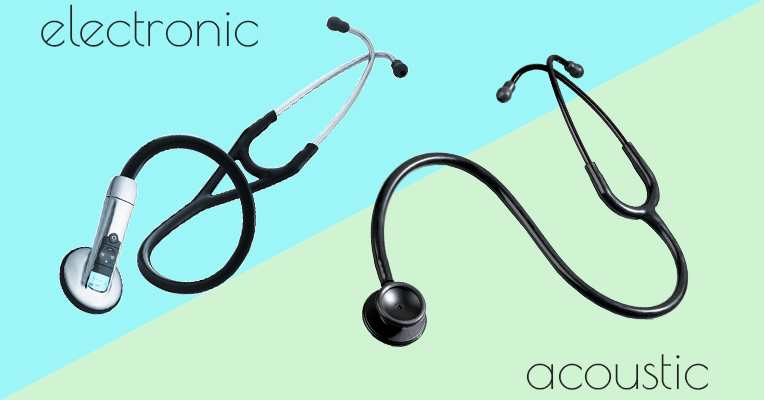
Invented over two centuries ago, a stethoscope is still widely used by healthcare specialists for initial diagnostics of numerous diseases and health conditions. Though the tool has undergone certain modifications, today, even the latest stethoscope models remain fairly simple medical devices. Commonly, a stethoscope consists of a headset and a chestpiece connected by a flexible tubing that transmits the sounds.
When it comes to the types of stethoscopes, by design, they fall into two major types. These are acoustic and electronic devices. While the first type is unpowered devices using the principles of acoustic, the second type is powered devices applying a digital technology to enhance traditional auscultation. Besides, stethoscopes can be differentiated by the intended use. Thus, a therapeutic stethoscope is used for almost all types of auscultation of an adult while pediatric models are designed with smaller chest pieces to improve the sound quality while auscultating children. Special neonatal stethoscopes meant for auscultation of newborns feature no-chill rings to stay warm during the contact with a baby's skin. The arsenal of obstetricians and midwives often includes a fetal stethoscope or a doppler. Both tools are designed for listening to the fetus heartbeat. The only difference is that a fetal stethoscope is a simple trumpet-like acoustic tool while a doppler is an electronic unit more sensitive to all sorts of sounds.
Practical Tips on the Stethoscope Use
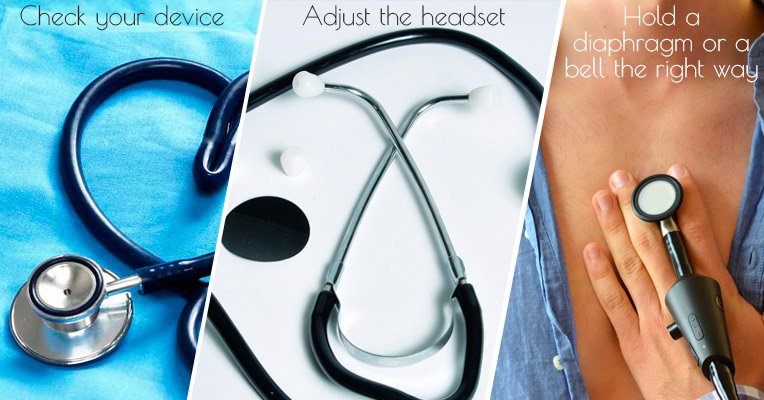
For quality auscultation, it is important to know how to wear a stethoscope, how to hold a diaphragm or a bell the right way, and how to correctly place it against the skin. Below, you will find 5 simple tips on the stethoscope use that will help all first-time users quickly get the hang of the tool while more experienced users can double check whether they do everything properly.
- The very first thing to do is to check your device for any possible damages. It's highly important to make sure that there are no loose parts in the chest piece or crack in the tubing since damages will prevent the airtight seal needed for efficient auscultation.
- Check for any potential obstructions. The stethoscope diaphragm should be placed right against the bare skin. Hence, a patient should take the clothes off or expose the area to be auscultated. Besides, their might be some dirt or debris accumulated on the diaphragm that will deteriorate the sound quality. So, clean your stethoscope regularly to maintain its due acoustic performance.
- Adjust the headset. Before placing the eartips into your ears, make sure they put somewhat forward. Such position ensures not only maximum comfort for the user but also a good seal to cancel surrounding noises and provide better sound transmission.
- Hold the chest piece between your index and middle fingers rather than use your fingertips for all-around grip. It will let you avoid excessive pressure and rubbing the diaphragm, all of this creating unnecessary noise.
- Place the diaphragm or the bell against the skin gently holding the chest piece and without applying too much pressure. This will let you hear the sounds more clearly.
Following these basic steps, you will always get the right auscultation results for quick and correct diagnostics essential for prescribing the further treatment and therapy.
However, auscultation techniques for listening with a stethoscope to different body areas are not the same and have certain peculiarities. For this reason, we've summarized instructions on how to auscultate various body areas that will help you obtain the necessary practical skill.
Where to Listen to Lung Sounds
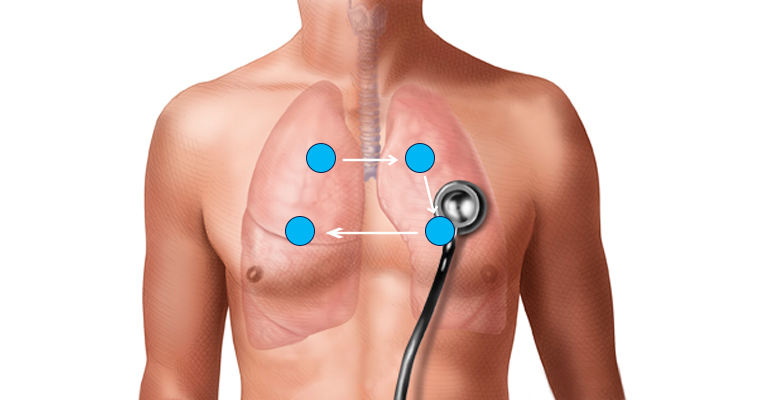
Our body is not quiet from the inside. Both our heart, lungs, intestinal tract and body vessels produce certain sounds. To hear breath sounds and filter them out of the rest, it is essential to place your stethoscope at the right position. This is where some knowledge of anatomy details is required. Thus, you should know that both lungs have lobes, two on the left and three on the right. The anterior point of the lungs is situated right above the collar bone. You should remember that muscles and bones disperse the sound. This is why it is better to avoid placing your stethoscope on the sternum or below a diaphragm. The best position for efficient lungs auscultation is in the posterior chest.
For accurate and efficient auscultation, have your patient sitting upright with arms on the lap. Use the stethoscope diaphragm and start listening from the top of the chest gradually moving to the bottom. Make sure to auscultate both sides listening to the front and to the back regions. During auscultation, the patient should breathe slowly and deeply through the mouth. Your major goal is to detect any weird sounds and abnormalities in breathe patterns. Normal breath is usually clear and reminds the sound of air being blown into a cup. Abnormal lung sounds such as wheezes, crackles or stridor might indicate some health problems.
Listening to the Heart
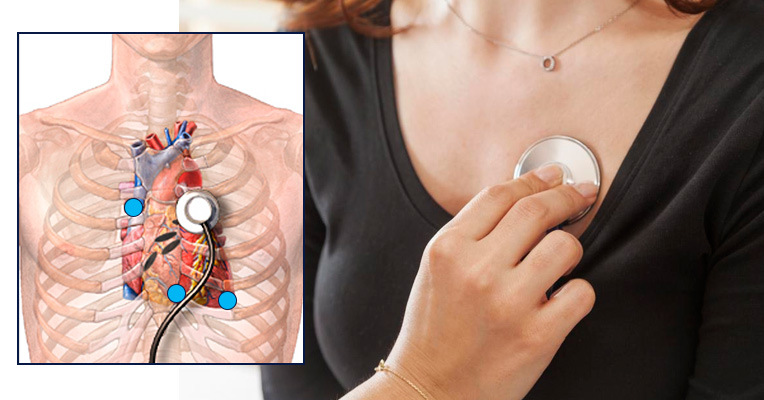
Listening to heart sounds and murmurs is the easiest and quickest way to diagnose some health conditions or even diseases at their early stages. Yet, to be able to do that, knowing heart auscultation basics is a must.
The optimal position for heart auscultation is the upper part of the chest somewhere between the fourth and sixth ribs. Apply the chest piece with only a gentle pressure to avoid hearing your fingers rubbing noise. The patient should sit or stand still and relaxed and breathe normally. Listen to the heart beating no less than a minute. Commonly, you will hear systolic and diastolic sounds. These are normal sounds of the human heart reminding "lub" and "dub" sounds. The "lub" sound refers to the blood ejection phase when the heart mitral and tricuspid valves close while the "dub" sound is a characteristic of the relaxation phase when ventricles fill with the blood. Another regular point of check during heart auscultation is the heart rate which is an essential characteristic of the heart health. For adults and children over 10 years, the resting heart rate usually varies from 60 to 100 heartbeats per minute depending upon the age. For newborns and kids below 10 years, the heart rate might range from 70 up to 190 heartbeats per minute. While counting the heartbeats, it is advisable to listen to any abnormal heart sounds using your stethoscope bell. Anything that sounds different from "lub-dub" might be considered beyond the norm and require a cardiologist consultation.
How Do You Take Blood Pressure With a Stethoscope?
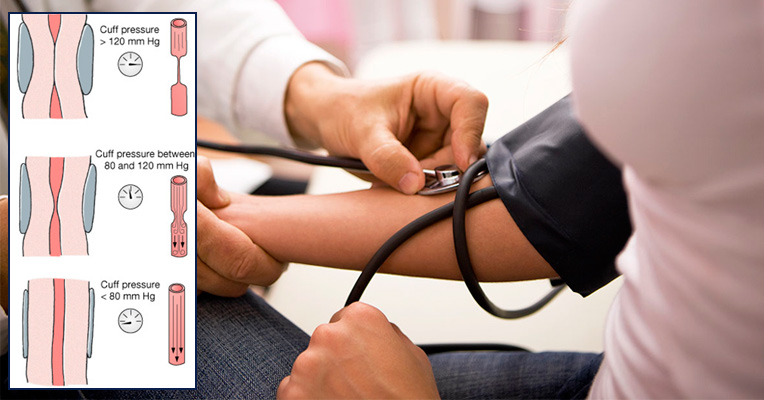
While many people would go for an electronic blood pressure monitor to measure their blood pressure at home, most health professionals choose the auscultatory method using a blood pressure cuff and a stethoscope.
Wrap a blood pressure cuff around the patient's arm above the elbow. The cuff should fit snugly without being too tight or too loose. Position the stethoscope diaphragm over the brachial artery below the cuff and pump the cuf untill you don't hear the pulse sound, normally it is at the point of 160-180 mmHg. Then start slowly deflating the cuff and listen to the pulse keeping your eyes on the cuff gauge (sphygmomanometer). The first distinct and clear pulse sound you will hear is your patient's systolic pressure and the reading where pulse sounds stop refers to a diastolic pressure. The norm for a systolic pressure should not exceed 120 mmHg and a diastolic pressure should not rise over 80 mmHg.
Abdominal Auscultation

Abdominal auscultation is one of the stages of the abdominal examination along with observation, percussion, and palpation. It allows assessing the bowel motility as well as evaluating vascular diseases.
To auscultate the abdomen, use your stethoscope diaphragm and place it on a bare stomach. The auscultation area is around the belly button. Normal bowel sounds resemble growling and grumbling that are the signs of healthy digestion and normal motility. The lack of sounds might be a sign of blockage or constipation while hyperactive sounds are often indicative of gastrointestinal disorders or food allergies.
Checking for Bruits
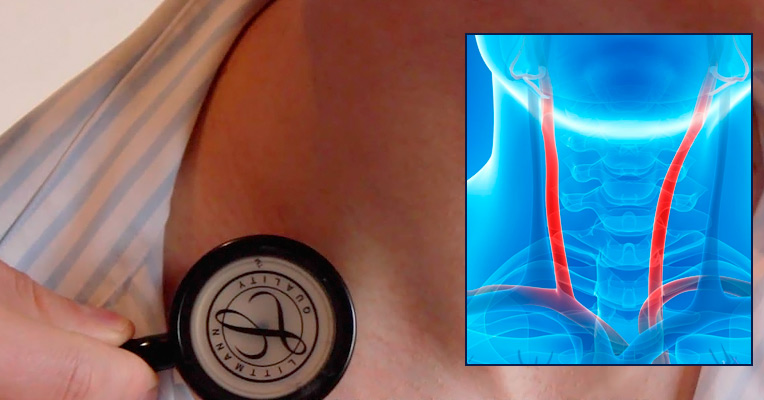
A bruit is a vascular murmur produced by a speedy blood flow through the artery. It might be caused by some kind of artery obstruction or a high blood flow in some part of the artery. A bruit is an abnormal sound that might accompany some vascular or heart diseases as well as vascular inefficiency.
To auscultate for a bruit, position the diaphragm of your stethoscope over a carotid artery. Carotid arteries are located on both sides of the Adam's apple in the front part of the neck. Refrain from pressing the diaphragm too hard to avoid blood circulation blockage.
Now that you know the proper way to use a stethoscope, listening with a stethoscope to the sounds of lungs and the heart shouldn't be a problem for you whatsoever.
how to use a stethoscope
Source: https://www.bestadvisor.com/how-to/how-to-use-a-stethoscope
Posted by: jantzenprolead.blogspot.com

0 Response to "how to use a stethoscope"
Post a Comment